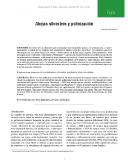Abejas silvestres y polinización

View/
ISSN
1659-0082Date
2005Author
Nates Parra, G.
Type
Artículo
Metadata
Show full item recordAlternative title
Wild bees and pollination
Description
3 ilus. Referencias bibliográficas en p. 18-20
Abstract
Un tercio de los alimentos que consumimos está disponible gracias a la polinización, y aproximadamente la mitad de los animales que polinizan las plantas tropicales son abejas. Se considera que en el Neotrópico hay casi 6000 especies de abejas - 3000 especies de lengua larga (Apidae y Megachilidae) y 3000 de lengua corta (Colletidae, Andrenidae y Halictidae) - que con sus visitas frecuentes a las flores se convierten en polinizadores eficientes, a diferencia de otros animales, que solo las visitan ocasionalmente. Para Colombia se estiman aproximadamente 1000 especies de abejas, agrupadas en 90 géneros y cinco familias. Este artículo versa sobre las abejas no-Apis y su relación con las plantas. Las abejas silvestres no-Apis conforman aproximadamente el 90 porciento del total de las abejas del mundo, son muy variadas, y su biología y sus relaciones con el ser humano son poco conocidas. One third of the food consumed by humans today is available to us thanks to pollination, and about half of the animals pollinating tropical plants are bees. It is thought that there are almost 6000 species of bees in the Neotropics - 3000 long-tongue species (Apidae and Megachilidae), and 3000 short-tongue species (Colletidae, Andrenidae and Halictidae) - which, through frequent visits to flowers, become efficient pollinators. In Colombia there are approximately 1000 bee species, grouped into 90 genera and five families. This paper focuses on non-Apis bees and their relationship with plants. Non-Apis bees make up nearly 90 percent of all bees, are extremely varied, and their biology and relations with human beings are little known
Publisher
CATIE, Turrialba (Costa Rica)

